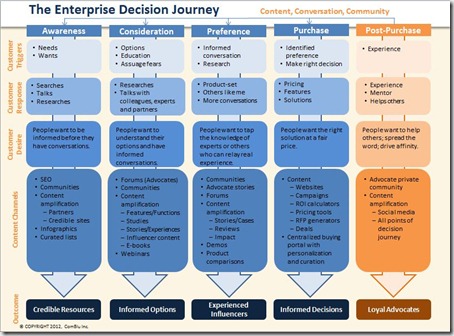By now, everyone has seen this Infographic. Yes, it is complex and confusing and it should give you a headache.
The tools to manage and measure activity on a socially enabled web today are growing at substantial rate. Today, you can track and measure virtually any activity you would want to or deploy a tool to help you manage social campaigns of virtually any type. A tool or an app has been built to address almost anything you might want to do.
This explosion of social tool development, while innovative and necessary, does little to solve the bigger problems of social engagement, which essentially boil down to understanding why people act the way they act in a social brand encounter and then helping to facilitate the right engagement and then understanding in simple clear terms the value and outcome of that encounter. That’s the bad news. The good news is this will change.
If you follow any innovation curve in virtually any industry, things tend to get harder and more complex before they get simpler and easier. Why? Because, during the early phases of innovation, the processes and rules and infrastructure that will later support new inventions are getting built right along with what’s being invented. Solving any one problem on its own is the goal. Later, problems get grouped together and a new smarter solution addresses them all.
Take the Model T automobile for example. Building the car on a mass scale was one thing. Tough enough to be sure, but what about manufacturing and distributing replacement parts as those cars began to break down? Sourcing, distributing and stocking virtually every part on the car separately was likely a daunting, painful and expensive exercise at the outset, for the supplier and the consumer.
In the end, things improved. They had to for the fledgling automotive industry to remain viable. All the confusion, competing systems and supply chain gaps needed to be streamlined and refined and new smarter and more innovative solutions and options were layered on based on understanding and meeting customer needs.
Innovators moved from activity metrics (which parts are needed) to value metrics (when to make and distribute them so that inventories matched demand) as the industry evolved.
Making sure that the customer could get the parts they needed when they needed it AFTER they purchased the vehicle helped to ensure that that customer would buy another auto from that manufacturer rather than a competitor’s product.
Social Marketing today is going through the same innovation phase as the early auto industry (and every other one for that matter). It will get better. For the industry to survive and remain relevant to users, it has to! The focus will begin to move away from the tools and the activity to the experience and the value of the relationship we deliver.
As this innovation occurs over the next few years, look for consolidation to speed up and for tools become more expansive, robust…and simpler. Tomorrow’s Infographic will look drastically different than the one at the beginning of this post. It will be less about the tools available and more about content, relationship triggers and the decision journey. That’s what tomorrow’s tools will help to manage-relationships and decision journeys, not just data.
Remember, keep your eye on the prize of understanding what is driving your value metrics; what is moving your constituents through the decision process and what compels them to remain involved with your brand. The tools which help you manage your social marketing initiatives will get better, be more intuitive and easier to use, I guarantee it.
Knowing this, social marketing practitioners and their business peers need to start focusing hard on what makes good relationships work. You must now begin the process of blurring the lines between all of your brand experience channels and optimizing those channels for relevance and value.
Get ready, as the next few years will bring marketing innovation and opportunities you have never imagined were possible.




